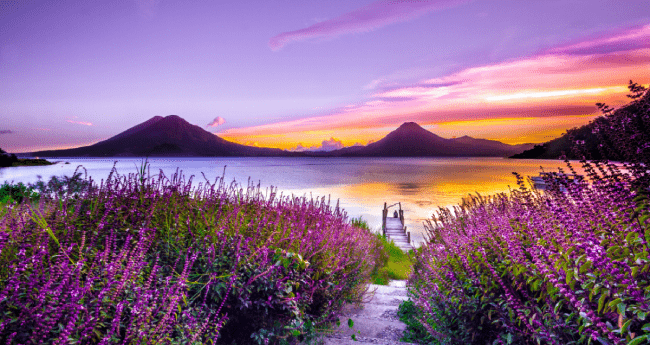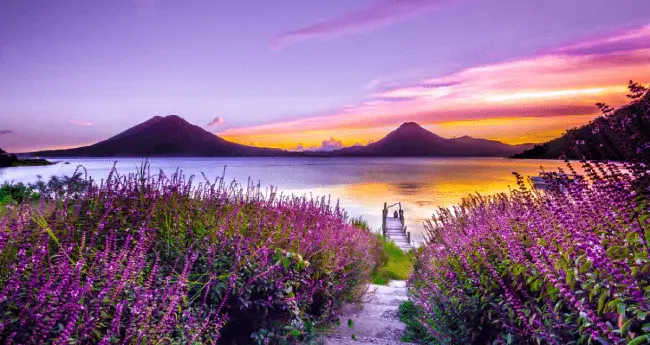
Guatemala Travel Guide: All you need to know to visit Guatemala in 2022
Welcome to Guatemala
Guatemala is a travel destination in Central America that pleases many different tourist profiles. You can enjoy adventure, be amazed by the historical sites or just relax by the beautiful lake Atitlan. It’s a country with a rich culture and breathtaking landscapes, a perfect place for a memorable trip.
In this complete Guatemala travel guide, we will share some travel tips, tricks, and everything you need to know to have a perfect trip to Guatemala.
Document checklist for Guatemala
-
Visa
-
Valid passport (for six months beyond the length of stay)
-
Sufficient funds
-
Return airline ticket
Essential Guatemala travel information
-
Currency - Guatemalan quetzal (Q). $1 is equivalent to approx. Q7.91.
-
Daily budget for 1 person - Allow a daily budget of Q304 ($39).
-
Languages - Spanish.
-
Socket type - Types A and B, 120V supply voltage and 60Hz.
-
Time zone - Greenwich Mean Time (GMT): GMT-06:00.
-
Top 3 cities to visit - Guatemala City, Antigua Guatemala, and Flores.
-
Top 3 landmarks/monuments - Lake Atitlán, Semuc Champey, and Tikal.
Visa information for Guatemala
Most travelers don’t need to apply in advance for a visa to visit Guatemala. More than 83 nationalities are in "Category A", which means they can travel to this country and get a visa stamp on arrival. This includes the United States, Canada, the UK, Australia, New Zealand, South Africa, Mexico, and most European countries.
Traveling to Guatemala, most visitors need only a passport from one of these visa-free countries (valid for at least six months and having at least one blank page) and proof of onward travel, such as a round-trip plane ticket. You can use the iVisa Checker Tool to see if you have a visa-free nationality.
For those needing a visa, it’s recommended to visit an embassy or consulate to apply and get further information.
Typical costs and budget for Guatemala
A basic guide to what you'll spend daily traveling through Guatemala on a decent budget.
Daily spending - Around Q304 ($39)/per person/per day on a budget vacation. This includes:
-
Meals - Q87 ($11)
-
Transport - Q55 ($7.05)
-
Hotel - Q203 ($26), for two people.
A trip for two for one week will cost, on average, Q4,259 ($546).
Transport and best ways to travel around Guatemala
You will probably arrive in Guatemala at the La Aurora International Airport. The country has a strategic position, so you can go from there to other Central American countries, such as El Salvador, or take domestic flights to visit cities distant from Guatemala City, which sometimes is pretty affordable.
The cheapest option for Guatemala travel is the chicken bus. The vehicles used to be US school buses, and now they are public transport in the country. They do intercity routes, for example, a three-hour ride from Antigua to Lake Atitlan. Chicken buses are not comfortable transportation, but they can be useful for a short trip in this country in Central America.
You also can use a shared van, which may be an option to balance time, money, and safety. This service will pick you up at a hotel in Antigua and drop you at a hotel in Panajachel, probably stopping and picking up other travelers on the way.
A rental car would allow you to explore the country on your own time, but be aware that the road conditions are not good. Additionally, drivers in Guatemala can be a bit reckless, making the road trip stressful.
Safety in Guatemala
Before planning the trip, most travelers ask: is Guatemala safe? Visiting Guatemala requires some precautions. The country faces violent crime in some areas; for example, you should avoid the San Marcos Department, it is considered a violent state in general but the capitol city of San Marcos is safe, same with the Huehuetenango Department, and the city of Huehuetenango is considered safe, Zone 18 and the city of Villa Nueva in Guatemala City due to high crime rates.
Petty crime, such as pickpocketing, is common. So pay attention in tourist areas and keep your valuables safe.
Weather in Guatemala
Guatemala has cool temperatures year-round, with an annual average temperature of 25°C(77°F). It’s never too hot or too cold; the factor in choosing when you travel is the precipitation.
But the best time to visit Guatemala is during the summer months, from November to March. It’s the dry season, so the best moment to enjoy outdoor activities and the beautiful beaches. Just be aware that it’s the peak tourist season: there will be crowds and services with a tourist price.
Otherwise, the rainy season is not a good time to travel to the Eternal Spring Land. The country has heavy rainfall from June to September. Additionally, the country has hurricane season in August and September. So these are months to avoid since no one wants to get stuck in a hotel during the trip.
Travel inspiration: Popular cities and towns in Guatemala
There are so many places to explore in the country! Here are some cities that you should include in your Guatemala itinerary:
-
Guatemala City - The capital is one of the big cities to visit. It’s a modern metropolis where you can enjoy the nightlife, street food, and a few excellent museums.
-
Antigua Guatemala - This was one of the most important colonial sites during the Spanish Empire. You can admire the Baroque architecture or beautiful natural sites since the city is in a gorgeous valley.
-
Flores - It’s an excellent base for exploring the Mayan ruins of Tikal, the wildlife in ARCAS (a rescue center), or the nearby cave of the serpent (Ak’tun Kan).
-
Todos Santos Cuchumatán - A great city to explore indigenous cultures and learn about the local traditions and Guatemalan culture. For example, you’ll see native Guatemalans wearing traditional clothing daily.
-
Monterrico - A destination for those looking for days at the beach. It has black volcanic sand beach and is the most developed beach city in the country. You can enjoy one of the many hotels and resorts in the town.
Tourist attractions: Must do and see in Guatemala
Don’t miss these remarkable sights on your trip to Guatemala:
-
Visit Lake Atitlan. The lake has an area of 130 km2, with a color that varies from deep blue to green, and offers a beautiful view, surrounded by Atitlán, Tolimán, and San Pedro volcanoes.
-
Hike in the Cuchumatanes Mountains. It’s a beautiful place to explore Guatemalan natural views.
-
Enjoy the celebrations of the Dia de Los Muertos. This is a holiday that takes place on the 1st and 2nd days of November throughout Latin America. It’s a beautiful party when Guatemalans remember their dead loved ones and celebrate that they were able to be part of their family.
-
Visit Tikal. This was one of the largest cities of the ancient Mayan civilization, dating back to approximately 200 A.D. to 850 A.D. Archaeologists estimate that Tikal’s population ranged from 50,000 to 100,000 inhabitants.
-
Relax in the Semuc Champey natural turquoise pools. This consists of a natural 300m limestone bridge, which passes the Cahabón River.
Typical Guatemalan food to try
-
Tamales - This traditional Guatemalan dish dates back to 8,000 to 5,000 B.C. It’s made with corn masa or rice flour and steamed in fresh plantain leaves or corn husks. The locals filled the tamales with various types of meat, cheeses, fruits, corn, tomatoes, bell peppers, roasted chilies, or other flavors.
-
Caldo de Res - Often called cocido or “cooked”, this beef broth is one of the most popular dishes in Guatemala cuisine. The first thing is to prepare the broth using the meat and bones before adding the vegetables, including carrots, corn, potatoes, and chayote squash. It’s served with rice, freshly made corn tortillas, or avocado slices.
-
Kak’ik’ - This is a Mayan dish recognized as one of the country’s dishes of intangible cultural heritage. It consists of turkey soup cooked in a lightly spiced red broth, prepared with native turkeys, tomatoes, cilantro, chilies, and achiote, which gives the soup a vibrant color.
Vaccine information for traveling to Guatemala
It's important to know what routine vaccines and COVID-19 measures are required for Guatemala travel, especially if you visit remote areas. We recommend you check the CDC website to learn more about vaccine requirements and any recommended guidance or medicine lists.
Be aware that travel insurance is not mandatory, but it’s a good idea to count on medical services coverage if you are on a trip.
Mayan Culture in Guatemala
The Maya were a pre-Columbian civilization that developed in Mesoamerica from approximately 1800 BC. Historians cannot explain what caused the Mayans’ decay. Meanwhile, reasons are suggested, such as lack of food due to land depletion and overpopulation, natural disasters, disease, and foreign attacks. They left incredible Mayan sites to explore and learn about their sophisticated lifestyle, the reason that many people travel to Guatemala.
You can see Mayan temples and ceramic artifacts in the country that were part of this curious history. Besides excelling in architecture, these people were outstanding astrologers, agronomists, and mathematicians. Tikal, Aguateca, and Quirigua are some of the spots in the country to see impressive Mayan Ruins.
Fun facts about Guatemala
Guatemala is a fascinating country! Besides the incredible sites, there are some curiosities about this place. Check out some facts and get even more interested in this culture.
-
22 languages are spoken in the country. Spanish is the official language, but 21 indigenous Mayan languages are spoken in the communities, and many are widely used today.
-
The Guatemalan Civil War was the longest in Latin American history. This war raged in Guatemala from 1960 to 1996.
-
Fuego is the most active volcano in Guatemala. It explodes 5-9 times per hour, but they are usually small explosions, producing impressive ash plumes. The last big eruption was in June 2018, which caught the locals off guard.
-
Guatemala coffee is consumed worldwide. Coffee is the most significant industry in the country and is famous for its great taste.
-
The country is home to three Unesco World Heritage sites: The ruins of Quirigua, the city of Tikal, and the cobbled streets of Antigua Guatemala. They are a great place to learn about the Mayan civilization's history and appreciate the picturesque colonial architecture.

 Australia ETA Online
Australia ETA Online
 United Kingdom ETA
United Kingdom ETA
 India Tourist eVisa
India Tourist eVisa
 Canada ETA Visa
Canada ETA Visa
 Turkey eVisa
Turkey eVisa
 Egypt eVisa
Egypt eVisa
 Singapore SG Arrival Card
Singapore SG Arrival Card
 Indonesia eVoa Visa
Indonesia eVoa Visa
 Aruba ED Card
Aruba ED Card

